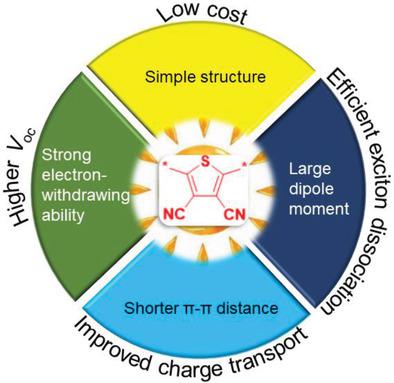当前位置:
X-MOL 学术
›
Adv. Energy Mater.
›
论文详情
Our official English website, www.x-mol.net, welcomes your
feedback! (Note: you will need to create a separate account there.)
3,4‐Dicyanothiophene—a Versatile Building Block for Efficient Nonfullerene Polymer Solar Cells
Advanced Energy Materials ( IF 24.4 ) Pub Date : 2020-02-07 , DOI: 10.1002/aenm.201904247 Bo Zhang 1, 2 , Yonggao Yu 1 , Jiadong Zhou 1 , Zhenfeng Wang 1 , Haoran Tang 1 , Shenkun Xie 1 , Zengqi Xie 1 , Liuyong Hu 2 , Hin‐Lap Yip 1 , Long Ye 1, 3, 4 , Harald Ade 4 , Zhitian Liu 2 , Zhicai He 1 , Chunhui Duan 1 , Fei Huang 1 , Yong Cao 1
Advanced Energy Materials ( IF 24.4 ) Pub Date : 2020-02-07 , DOI: 10.1002/aenm.201904247 Bo Zhang 1, 2 , Yonggao Yu 1 , Jiadong Zhou 1 , Zhenfeng Wang 1 , Haoran Tang 1 , Shenkun Xie 1 , Zengqi Xie 1 , Liuyong Hu 2 , Hin‐Lap Yip 1 , Long Ye 1, 3, 4 , Harald Ade 4 , Zhitian Liu 2 , Zhicai He 1 , Chunhui Duan 1 , Fei Huang 1 , Yong Cao 1
Affiliation

|
In this contribution, a versatile building block, 3,4‐dicyanothiophene (DCT), which possesses structural simplicity and synthetic accessibility for constructing high‐performance, low‐cost, wide‐bandgap conjugated polymers for use as donors in polymer solar cells (PSCs), is reported. A prototype polymer, PB3TCN‐C66, and its cyano‐free analogue polymer PB3T‐C66, are synthesized to evaluate the potential of using DCT in nonfullerene PSCs. A stronger aggregation property in solution, higher thermal transition temperatures with higher enthalpies, a larger dipole moment, higher relative dielectric constant, and more linear conformation are exhibited by PB3TCN‐C66. Solar cells employing IT‐4F as the electron acceptor offer power conversion efficiencies (PCEs) of 11.2% and 2.3% for PB3TCN‐C66 and PB3T‐C66, respectively. Morphological characterizations reveal that the PB3TCN‐C66:IT‐4F blend exhibits better π–π paracrystallinity, a contracted domain size, and higher phase purity, consistent with its higher molecular interaction parameter, derived from thermodynamic calculations. Moreover, PB3TCN‐C66 offers a higher open‐circuit voltage and reduced energy loss than most state‐of‐the‐art wide‐bandgap polymers, without the need of additional electron‐withdrawing substituents. Two additional polymers derived from DCT also demonstrate promising performance with a higher PCE of 13.4% being achieved. Thus, DCT represents a versatile and promising building block for constructing high‐performance, low‐cost, conjugated polymers for application in PSCs.
中文翻译:

3,4-二氰基噻吩—高效非富勒烯聚合物太阳能电池的多功能构建基块
在此贡献中,一种通用的构建基3,4-二氰基噻吩(DCT)具有结构简单性和合成可及性,可用于构建高性能,低成本,宽带隙共轭聚合物,用作聚合物太阳能电池(PSC)的供体),被报告。合成了原型聚合物PB3TCN-C66及其不含氰的类似物聚合物PB3T-C66,以评估在非富勒烯PSC中使用DCT的潜力。PB3TCN-C66具有更强的聚集特性,更高的热转变温度和更高的焓,更大的偶极矩,更高的相对介电常数和更多的线性构象。使用IT-4F作为电子受体的太阳能电池,PB3TCN-C66和PB3T-C66的功率转换效率(PCE)分别为11.2%和2.3%。形态学特征表明,PB3TCN-C66:IT-4F共混物表现出更好的π-π结晶度,收缩的畴尺寸和更高的相纯度,这与从热力学计算得出的更高的分子相互作用参数一致。此外,与大多数最新的宽带隙聚合物相比,PB3TCN-C66具有更高的开路电压和更低的能量损耗,而无需额外的吸电子取代基。衍生自DCT的另外两种聚合物也表现出令人鼓舞的性能,可实现13.4%的更高PCE。因此,DCT代表了一种通用且有前途的构建基块,用于构建高性能,低成本,共轭聚合物以用于PSC。与热力学计算得出的分子相互作用参数更高一致。此外,与大多数最新的宽带隙聚合物相比,PB3TCN-C66具有更高的开路电压和更低的能量损耗,而无需额外的吸电子取代基。衍生自DCT的另外两种聚合物也表现出令人鼓舞的性能,可实现13.4%的更高PCE。因此,DCT代表了一种通用且有前途的构建基块,用于构建高性能,低成本,共轭聚合物以用于PSC。与热力学计算得出的分子相互作用参数更高一致。此外,与大多数最新的宽带隙聚合物相比,PB3TCN-C66具有更高的开路电压和更低的能量损耗,而无需额外的吸电子取代基。衍生自DCT的另外两种聚合物也表现出令人鼓舞的性能,可实现13.4%的更高PCE。因此,DCT代表了一种通用且有前途的构建基块,可用于构建高性能,低成本,共轭聚合物以用于PSC。无需其他吸电子取代基。衍生自DCT的另外两种聚合物也表现出令人鼓舞的性能,可实现13.4%的更高PCE。因此,DCT代表了一种通用且有前途的构建基块,可用于构建高性能,低成本,共轭聚合物以用于PSC。无需其他吸电子取代基。衍生自DCT的另外两种聚合物也表现出令人鼓舞的性能,可实现13.4%的更高PCE。因此,DCT代表了一种通用且有前途的构建基块,可用于构建高性能,低成本,共轭聚合物以用于PSC。
更新日期:2020-03-27
中文翻译:

3,4-二氰基噻吩—高效非富勒烯聚合物太阳能电池的多功能构建基块
在此贡献中,一种通用的构建基3,4-二氰基噻吩(DCT)具有结构简单性和合成可及性,可用于构建高性能,低成本,宽带隙共轭聚合物,用作聚合物太阳能电池(PSC)的供体),被报告。合成了原型聚合物PB3TCN-C66及其不含氰的类似物聚合物PB3T-C66,以评估在非富勒烯PSC中使用DCT的潜力。PB3TCN-C66具有更强的聚集特性,更高的热转变温度和更高的焓,更大的偶极矩,更高的相对介电常数和更多的线性构象。使用IT-4F作为电子受体的太阳能电池,PB3TCN-C66和PB3T-C66的功率转换效率(PCE)分别为11.2%和2.3%。形态学特征表明,PB3TCN-C66:IT-4F共混物表现出更好的π-π结晶度,收缩的畴尺寸和更高的相纯度,这与从热力学计算得出的更高的分子相互作用参数一致。此外,与大多数最新的宽带隙聚合物相比,PB3TCN-C66具有更高的开路电压和更低的能量损耗,而无需额外的吸电子取代基。衍生自DCT的另外两种聚合物也表现出令人鼓舞的性能,可实现13.4%的更高PCE。因此,DCT代表了一种通用且有前途的构建基块,用于构建高性能,低成本,共轭聚合物以用于PSC。与热力学计算得出的分子相互作用参数更高一致。此外,与大多数最新的宽带隙聚合物相比,PB3TCN-C66具有更高的开路电压和更低的能量损耗,而无需额外的吸电子取代基。衍生自DCT的另外两种聚合物也表现出令人鼓舞的性能,可实现13.4%的更高PCE。因此,DCT代表了一种通用且有前途的构建基块,用于构建高性能,低成本,共轭聚合物以用于PSC。与热力学计算得出的分子相互作用参数更高一致。此外,与大多数最新的宽带隙聚合物相比,PB3TCN-C66具有更高的开路电压和更低的能量损耗,而无需额外的吸电子取代基。衍生自DCT的另外两种聚合物也表现出令人鼓舞的性能,可实现13.4%的更高PCE。因此,DCT代表了一种通用且有前途的构建基块,可用于构建高性能,低成本,共轭聚合物以用于PSC。无需其他吸电子取代基。衍生自DCT的另外两种聚合物也表现出令人鼓舞的性能,可实现13.4%的更高PCE。因此,DCT代表了一种通用且有前途的构建基块,可用于构建高性能,低成本,共轭聚合物以用于PSC。无需其他吸电子取代基。衍生自DCT的另外两种聚合物也表现出令人鼓舞的性能,可实现13.4%的更高PCE。因此,DCT代表了一种通用且有前途的构建基块,可用于构建高性能,低成本,共轭聚合物以用于PSC。











































 京公网安备 11010802027423号
京公网安备 11010802027423号